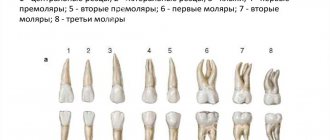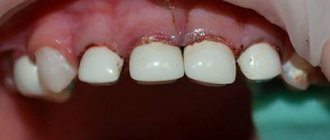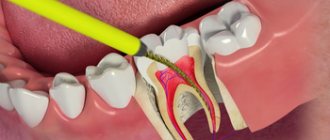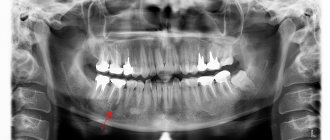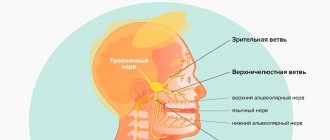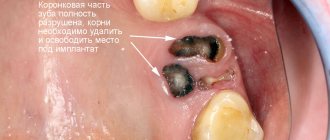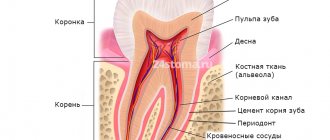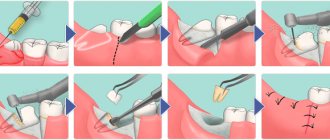Change in tooth color (darkening of the tooth) - when a nerve is removed
When the nerve is removed from the tooth, after a while (from six months to several years) due to the fact that the nervous, circulatory and lymphatic supply to the tooth has ceased, the color of the tooth changes - discoloration and darkening are noted in the future. If chewing teeth have been depulped, the color change is not noticeable in most patients, unlike the front teeth. Anterior teeth after root canal treatment often require color correction to achieve smile aesthetics. This is achieved through endodontic whitening, veneers, or crowning such teeth. In most cases, when the crown of a tooth is filled or a permanent crown-shaped prosthesis is installed after root canal treatment, this discoloration is not noticeable. In cases where a tooth crown is not required, and the tooth itself is located in the frontal area of the smile, whitening or veneering helps eliminate discoloration of the teeth.
How long does a tooth hurt after nerve removal?
It should be noted that pain for several days after removing the nerve and filling the canals is a natural reaction of the body to the intervention. Dentists call this condition post-filling pain. During the procedure of pulp extraction and canal treatment, microtrauma to surrounding tissues is inevitable, so after the anesthesia wears off, the patient may experience discomfort. Normally, they are easily relieved with analgesics and gradually disappear.
The following symptoms indicate complications:
- 5-7 days after removal of the nerve, the tooth still hurts;
- the pain is strong and sharp;
- painkillers do not relieve pain;
- gum inflammation;
- the temperature has risen;
- headache;
- the pain spread to other teeth.
In this case, you should immediately consult a doctor so that he can do an x-ray or CT scan and find out the cause of the complication.
Tooth weakening - after nerve removal
Because the tooth structure is slightly weakened after root canal treatment, the tooth loses some of its original capabilities. This translates into a higher risk of tooth fractures. Those patients who have had root canal treatment should avoid eating hard foods, such as nuts, or using other teeth to chew on them. To avoid the risk of tooth fracture after root canal treatment, you should consider installing a dental crown.
Failed root canal treatment
Root canal treatment may fail in approximately 5% of patients. This often leads to tooth extraction. Such cases occur for various reasons, sometimes even independent of the quality of canal filling.
Other reasons
Other reasons that can cause severe pain after nerve removal include:
- allergic reactions to the use of materials during treatment, in addition to pain, itching, swelling;
- tissue injury, gum damage (accompanied by inflammatory processes, swelling, pain);
- neuralgia (damage to the trigeminal nerve during treatment can cause sharp, severe pain).
How to eliminate pain after depulpation?
Doctors recommend a number of preventive measures that can help prevent the development of discomfort after nerve removal:
- immediately after depulpation, you should follow the doctor’s advice, do not remove the cotton swab in the first twenty minutes;
- the first day you should refrain from solid, cold or hot food, smoking;
- The mouth should be rinsed at the frequency specified by the doctor; during the first days, do not disturb the sore area with a brush while brushing your teeth;
- for three days, rinse your mouth with neutral antiseptic agents at least twice a day.
Doctor's recommendations
To prevent complications and pain, the patient must adhere to the doctor’s recommendations. On the first day after treatment, you should rinse your mouth with a soda solution with the addition of a small amount of iodine. You can alleviate the condition by taking painkillers and avoiding eating solid food, hot or cold, on the first day. It is also recommended to refrain from physical activity.
You can alleviate the condition using the following methods:
- Propolis. To eliminate pain, you need to apply a small piece of propolis to the painful area, the discomfort quickly passes, the product has a disinfecting, anti-inflammatory effect.
- Vodka or cognac. If there is sharp, ongoing pain after removal, you can use rinses with cognac or regular vodka. The pain goes away quickly, alcohol has a disinfecting effect, eliminating infection of the diseased area.
- Rinse with vegetable oil. This remedy calms and alleviates the condition. You need to hold a small amount of the product in your mouth; you should spit out the oil after it turns whitish.
- Salo. You can relieve pain by applying it to the wound after removing the nerve.
- Ice compresses. An effective way to relieve pain and swelling is a crushed ice compress. You can make such compresses yourself or buy special ones at the pharmacy. They are applied to the cheek opposite the painful area. Instead of compresses, you can use an ice cube, holding it near the painful tooth.
When is it necessary to see a doctor?
After nerve removal, the patient should monitor the condition of the tissue. If the pain does not go away, you should consult a doctor who will conduct an examination and prescribe treatment. Also, contacting the clinic is required in the following cases:
- tissue swelling develops, which does not go away and intensifies over time;
- the throat feels sore, chewing and swallowing are difficult;
- purulent discharge appears;
- an unpleasant odor appears from the mouth.
Self-treatment in this case will only worsen the situation. If you do not consult a doctor, complications are likely to develop, including granulomas, cysts, and other dangerous diseases.
Infectious disease - when a nerve is removed
There is a small risk that a tooth after root canal treatment may become infected, like other teeth. If, after treating a tooth with root canal treatment, you notice symptoms of infection (inflammation of the gums, pain “inside the gum” or “above/below the tooth,” etc.), you should immediately contact your dentist for re-treatment.
Some precautions to take after tooth nerve removal and root canal treatment
Have you treated your tooth with root canal treatment? So you must take the following precautions. Most of these instructions apply to all people, even those unlucky enough not to have undergone a root canal procedure.
- Avoid chewing foods that are too hard, such as raw nuts, on a tooth that has had a root canal.
- Brush your teeth twice a day and use dental floss or floss.
- Don't forget to rinse your mouth after meals or snacks.
- Maintain good oral hygiene (periodically changing toothpaste, visiting the dentist for teeth cleaning)
- Get rid of bad habits such as smoking tobacco.
Pain after filling
Most often, pain appears after removing the nerve and filling the canal. The reasons are usually poor-quality filling of cavities, allergic reactions to materials used for treatment, or microtrauma to tissues. The patient may experience the following symptoms:
- the tooth is sensitive to hot, cold food, touch;
- when closing the jaws, chewing, discomfort is felt;
- sharp, twitching pain develops at night and in the evening;
- eating becomes difficult.
General health worsens, headaches, tissue inflammation, and swelling of the cheek appear. If this condition lasts more than a week, you should urgently consult a doctor for treatment.
Main reasons
So why does a tooth hurt after nerve removal? In most cases, this is caused by poor quality work by the dentist. High-quality treatment of canals requires precision, accuracy and excellent mastery of technology, and inattention and careless attitude lead to errors in treatment, which in turn lead to very painful complications.
Here are the possible causes of pain after nerve removal.
The canals are not completely closed with filling material
If the doctor made a mistake when assessing the depth of the canals and did not seal them completely, then over time bacteria can accumulate in the voids and provoke an inflammatory process. This error does not manifest itself immediately: for quite a long time the patient may think that everything is fine. However, sooner or later destructive processes will still manifest themselves - as a rule, sharp pain that appears on its own or when pressing on the tooth. Inflammation in an unclosed canal can lead to destruction of the tooth root, the formation of a granuloma or cyst.
The filling material has gone beyond the root
One of the most common complications is in which, after removal of the nerve, the tooth hurts when pressing and biting food. The situation is exactly the opposite of the previous one: in this case, the cause of pain in the tooth after removal of the nerve is not the lack of filling paste in the canal, but its excess. The paste enters the jawbone, causing irritation, inflammation and the body's immune response to the foreign body. Pain appears immediately after obturation (filling) of the canals, and its intensity directly depends on the amount of paste that has gone beyond the tooth root: the larger the volume of the foreign body in the jaw bone, the stronger the discomfort.
The end of the dental instrument broke off and remained in the canal
This also happens. To extract the pulp and process the canals, very thin instruments are used, which require high precision from the doctor. If manipulations are performed with excessive pressure on the instrument, without the use of a special lubricating gel, or simply carelessly, then the thin end of the endodontic instrument may break off and remain in the root canal. Then access to the canal will be blocked, and its high-quality processing and filling will become impossible. Over time, this will certainly lead to inflammation, pain and destruction of the tooth root.
Perforation of the tooth root occurred during canal treatment
Perforation is a puncture of the root wall during canal processing with an endodontic instrument. It is dangerous in itself: it can lead to inflammation and suppuration of the tissue in the puncture area, but also through the hole, filling material can get into the jawbone with all the ensuing consequences. Due to anesthesia, the patient will not feel the moment of the puncture, but after the effect of the painkillers wears off, he will definitely feel a sharp pain. It is practically not relieved by analgesics.
The carious cavities were not drilled out completely
Another “delayed” complication after nerve removal is when the doctor inadvertently leaves caries-affected tissue in the tooth. A filled tooth may not remind you of itself for several weeks or even months, but sooner or later the unpleasant sensations will definitely return. Pathogenic bacteria will continue the process of tooth destruction, affecting healthy tissue, causing inflammation and pain.
The patient had an allergic reaction to the components of the filling paste
This is the only cause of post-filling complications that does not depend on the actions of the doctor. Individual intolerance to the filling material leads to swelling of the gums, burning, and nagging pain in the area of intervention. After removal of the nerve, the tooth aches, the eyes may become watery, the lips and cheeks may swell, there may be nasal congestion and even a rise in temperature.



